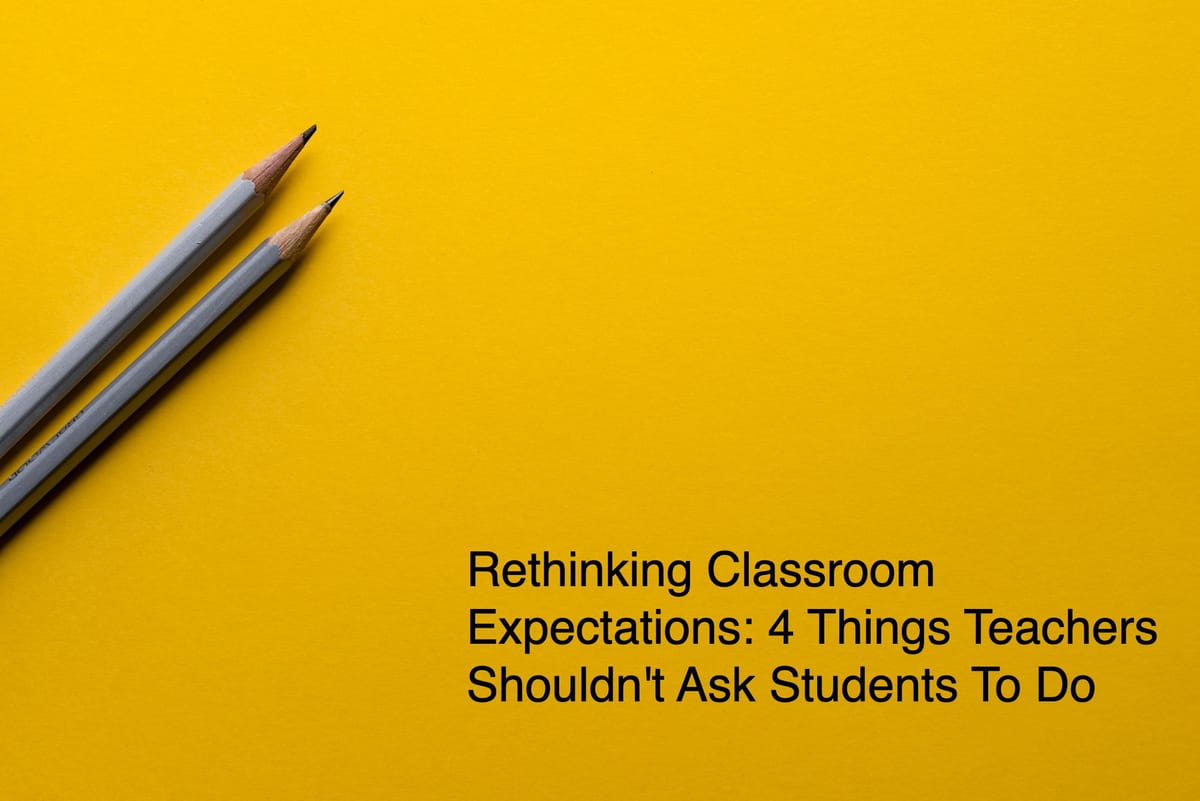Rethinking Classroom Expectations: 4 Things Teachers Shouldn't Ask Students To Do
As teachers, we always want the best for our students, setting high standards and pushing them to excel. But sometimes, it's important to step back and ask ourselves if these expectations are truly fair.

As teachers, we always want the best for our students, setting high standards and pushing them to excel. But sometimes, it's important to step back and ask ourselves if these expectations are truly fair. Inspired by Justin Minkel's article in Education Week - 4 Things Teachers Shouldn’t Be Asking Their Students to Do, here are four things we might want to reconsider asking our students to do.
Can a classroom truly be silent?
We often expect our students to be quiet, but think about how hard it is for adults to stay silent during meetings or training sessions. Maybe it’s time to accept that a completely quiet classroom isn’t always realistic or necessary. Instead, we can focus on creating a balanced environment where students feel free to express themselves while respecting the need for quiet.
Try This
- Set Clear Expectations: Start by setting clear rules and expectations about noise levels. Make sure students understand when it's appropriate to talk and when they should be quiet. Use visual aids, such as a noise level chart, to help students gauge their volume.
- Use Non-Verbal Signals: Implement non-verbal signals to manage noise. For example, you can use hand signals, a bell, or a visual cue like a traffic light system where green means talking is allowed, yellow means whispering, and red means silence.
- Incorporate Structured Talk Time: Allow for structured talk time where students can share ideas and collaborate. This can be in the form of group work or pair discussions. By giving students designated times to talk, you can better manage noise levels and ensure that they have the opportunity to express themselves.
Can all of your students realistically sit still?
We know it’s tough for kids to stay seated for long periods, yet we often require it. Incorporating regular brain breaks can make a huge difference. These short breaks for movement or a change in activity can refresh both students and teachers, making the learning process more dynamic and less monotonous.
Try This
- Incorporate Flexible Seating: Allow students to choose from a variety of seating options, such as standing desks, floor cushions, or stability balls. This can help students feel more comfortable and reduce the need to move around excessively.
- Scheduled Movement Breaks: Implement regular, scheduled breaks that allow students to stand up, stretch, and move around. These breaks can be short and structured, such as a quick dance activity or a series of simple exercises.
- Active Learning Strategies: Use teaching methods that require movement, such as learning stations, gallery walks, or interactive activities. This helps manage movement, keeps students engaged, and enhances learning through physical activity.
What about apologies?
Forced apologies are another area worth rethinking. We want our students to feel genuine remorse and make amends, but a forced apology often lacks sincerity. A better approach might be restorative practices, where students actively work to fix their mistakes. This helps repair relationships and teaches them about accountability and empathy.
Try This
- Implement Restorative Practices: Instead of forcing apologies, encourage students to engage in restorative practices. Have them actively work to fix their mistakes, which helps repair relationships and teaches accountability and empathy.
- Create a Reflective Environment: Allow students time and space to reflect on their actions and understand the impact of their behavior. This can be done through guided questions or reflection journals, helping them to genuinely feel remorse and make meaningful amends.
- Teach Conflict Resolution Skills: Equip students with the skills needed to resolve conflicts on their own. Role-playing scenarios and teaching effective communication techniques can help students navigate challenging situations and foster a more respectful and empathetic classroom environment.
How much should students be asked to remember?
It’s easy to get frustrated when students forget things or ask repetitive questions, but remember, they’re still developing. Adult educators forget things every day. We need to show patience and understanding. It’s also our job to teach students habits and skills that will help them become more organized. Offering grace and support can also help them grow more confident.
Try This
- Use Visual Aids and Organizational Tools: Visual aids such as charts, calendars, and checklists can help students keep track of their assignments and important dates. Tools like planners or digital apps can also assist students in organizing their tasks and due dates effectively.
- Repetition and Reinforcement: Regularly review key concepts and instructions to reinforce memory. This can be done through quick daily reviews, interactive activities, or incorporating repetition into lessons, helping students to better retain information.
- Teach and Encourage Note-Taking Skills: Instruct students on effective note-taking techniques and encourage them to use these skills during lessons. Providing structured note templates can also help students organize information systematically, making it easier to remember and review later.
Even adults in educational settings exhibit similar behaviors, so if we can be patient with them, we should extend the same courtesy to our young students. Setting realistic expectations and approaching our students with empathy can foster a more positive and effective learning environment for everyone.

❤ Enjoy this Article?
🍵 Show Your Support and 🤗 Share It



